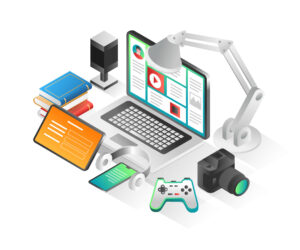Table of contents:
The realm of application development is undergoing a groundbreaking transformation propelled by the influential force of generative AI. In this comprehensive exploration, we delve into the far-reaching effects of generative AI on coding practices, testing methodologies, and the overall landscape of application development.
Generative AI in Application Development:
The paradigm shift brought about by generative AI is both significant and attention-demanding. With many years of experience at this sphere, we can attest that the pace of change, especially in the field of generative AI, is truly unprecedented.
AI augmented development is reshaping the very foundations of how applications are constructed. This transformative approach incorporates AI, generative AI, and machine learning models into the fabric of code production, design-to-code processes, and AI-enhanced testing. Code generation emerges as the most widely adopted capability, with approximately 25% of enterprises actively integrating this technology into their development processes.
Efficiency through Code Generation:
Code generation proves to be a game-changer, particularly in handling boilerplate code, facilitating rapid code refactoring, and transitioning from older to modern frameworks and languages. Despite occasional imperfections, such as mistakes and security flaws originating from training on public code repositories, developers widely embrace these tools. Senior engineers, acknowledging these imperfections, still find the tools immensely helpful, and once integrated, they become indispensable. The dynamic adoption of AI in application development is swiftly transforming the industry.
At the heart of this evolution is a machine learning-powered coding assistant seamlessly integrated into developers’ IDEs or code editors. These tools, powered by large language models like GPT-4, Palm, and Cody, leverage repositories to learn coding patterns. Soon, they will empower developers to influence models by integrating their curated code repositories, further enhancing model performance.
Challenges and Realistic Productivity Improvements:
While providers in the marketplace boast about substantial productivity improvements, it is crucial to acknowledge the realistic context. Software engineers do not spend 100% of their time writing code; it’s more likely around 15%. Hence, a 40% improvement on 15% translates to a 6% overall improvement. Real-world cases showcase measured productivity improvements, with a client reporting a 5% boost, amounting to $2 million annually with 15,000 developers.
Beyond code generation, generative AI extends its influence to documentation, code analysis, documentation search, and DevOps automation. Tools like Code Whisper, Askcode, and Codium play a crucial role in automating various aspects of development, with a growing trend toward incorporating operations in DevOps.
In the realm of AI augmented testing, these tools significantly reduce cycle times, allowing for rapid releases and improved software quality. Prioritized by software engineering leaders, they automate risk identification, decision-making, autonomous exploration, test case generation, and human-like error detection, proving invaluable in design-to-code processes.
Integration of Design and Development:
A notable shift is witnessed in the growing integration between designers and development teams, eliminating traditional handoff models. Design-to-code tools now offer fully coded screens with minimal refactoring, facilitating seamless collaboration from inception to deployment.
The industry is steering towards an integrated design and development environment with customized workflows, offering different perspectives for designers and developers. Anticipated expansion into release management, production integrations, and application configuration and monitoring marks the ongoing evolution.
The Transformative Impact of Generative AI:
Cumulatively, these changes usher in a fundamentally different work environment for development teams, enhancing speed, efficiency, and developer satisfaction by automating tedious tasks. Generative AI stands as a transformative force, promising a dynamic landscape for developers.
Generative AI is poised to revolutionize both application development processes and the very nature of applications. Four major disruptions, including the need for prompt engineering skills, a shift towards conversational applications, the rise of proactive and interactive applications, and a substantial rethinking of UX, are on the horizon.
The Emergence of Very Large Language Models (LLMs):
The introduction of Very Large Language Models (LLMs) like GPT-4, Palm, Titan, or Quad Two is a noteworthy development. These models, inherently conversational and pre-built, address various use cases without the need for defining intents or entities. However, they come with limitations, such as being closed, stateless, and expensive to train and operate.
Addressing challenges related to prompt engineering, especially in managing token costs, becomes imperative. Grounding and retrieval augmented generation activities can significantly reduce hallucination rates, overcoming challenges associated with large language models like GPT 3.5 or 3.5 Turbo.
Integration of Conversational Features:
The industry faces pressure to swiftly incorporate conversational features into applications, with Microsoft 365 Copilot and Google’s Duet AI enhancing conversational capabilities. Applications, once reactive, now have the potential to become proactive or interactive, suggesting information based on user requests.
The shift to proactive and interactive applications necessitates a redesign of user interfaces (UI). Current UIs heavily rely on visual elements, but with conversational interfaces gaining prominence, designers must strike a balance in distributing information between visual and conversational modalities.
Recommendations for Successful Adoption:
To navigate the evolving landscape, organizations are advised to adopt AI code generation tools such as GitHub Copilot, Amazon Code Whisper, or Tab Nine. Specialized tools like IBM’s Project Wisdom cater to specific environments, promoting efficient modernization. Design-to-code platforms facilitate better integration between development and design teams. Developing prompt engineering skills, assuming generative AI-enabled interactions, and establishing a Generative AI Center of Excellence are crucial steps for successful adoption.
Conclusion:
Generative AI emerges as a force reshaping the very fabric of application development. As organizations embrace this transformative technology, they must equip their workforce with the necessary skills and foster a culture of innovation. The future promises a dynamic landscape where developers, armed with generative AI, can redefine the boundaries of what’s possible.


